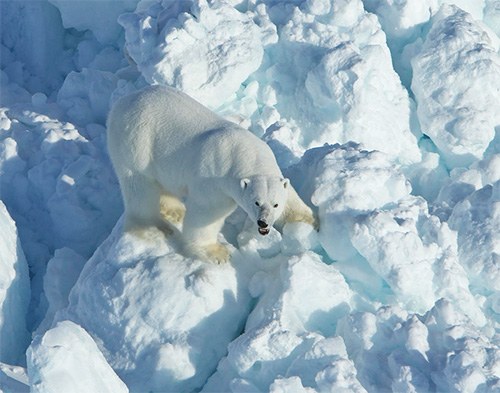
Increased Sea Ice Drift Puts Polar Bears on Faster Moving Treadmill
June 13, 2017
These findings represent the first assessment of the consequences of changing drift rates for polar bears; one of several previously unexplored effects of sea ice loss. “Increased sea ice drift rates likely exacerbate the physiological stress due to reduced foraging opportunity already experienced by many polar bears in the warming Arctic,” said Dr. George Durner, research ecologist with the USGS and lead author of the report, “adding yet another ‘straw to the camel’s back.’”
The results were derived from radio-tracking data of collared adult female polar bears in the Beaufort and Chukchi seas coupled with sea ice drift data from the National Snow and Ice Data Center. The data, comprising of over 77,000 bear locations and matching ice drift values, were collected during two periods with different sea ice characteristics, 1987-1998 and 1999-2013. “These were very intensive analyses requiring advanced computational capabilities,” said Dr. Shannon Albeke a spatial ecologist with the Wyoming Geographic Information Science Center. “It was probably the most complicated analysis of my career.” “This study demonstrates the unparalleled value of long-term uninterrupted data collection,” said Dr. Merav Ben-David from the Department of Zoology and Physiology at the University of Wyoming. “Without access to the ice data from NSIDC, and the interagency and international cooperation, we could not have conducted this project.” The study estimates that polar bears must catch and consume one to three more seals per year (a 2-to 6-percent increase) in order to compensate for the higher expenditure of living on faster drifting ice. This elevated energy expenditure is concurrent with a diminished availability of sea ice suitable for hunting seals, due to early ice melt in spring and expansive ice melt during summer. The need to travel longer distances coincides with deterioration of the ice surface, on which polar bears walk, creating a complex and difficult environment to transverse. The study showed that during the recent period, a solitary adult female polar bear required between 2,800,000 and 3,200,000 kcal annually. This was 51,000-to 107,000-kcal more than during the early period and is 3 ½ to 4 times greater than total energy requirements of a moderately active adult human female. The paper entitled “Increased Arctic sea ice drift alters polar bear movements and energetics” was published Tuesday by the journal Global Change Biology. Partners in this research included the U.S. Fish and Wildlife Service, Environment and Climate Change Canada, and Polar Bears International.
Reporting and Editing by Mary Kauffman, SitNews
Source of News:
Representations of fact and opinions in comments posted are solely those of the individual posters and do not represent the opinions of Sitnews.
|
|||
